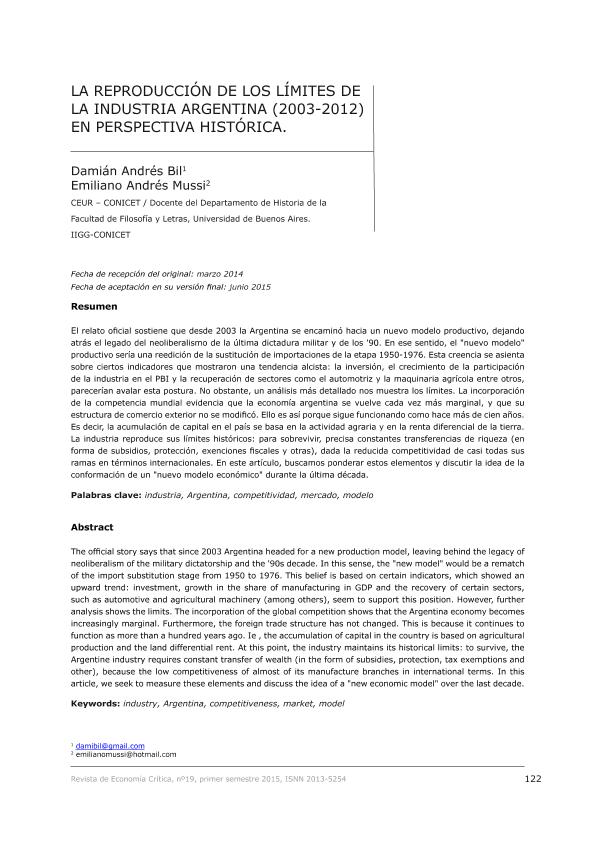Artículo
El relato oficial sostiene que desde 2003 la Argentina se encaminó hacia un nuevo modelo productivo, dejando atrás el legado del neoliberalismo de la última dictadura militar y de los ´90. En ese sentido, el "nuevo modelo" productivo sería una reedición de la sustitución de importaciones de la etapa 1950-1976. Esta creencia se asienta sobre ciertos indicadores que mostraron una tendencia alcista: la inversión, el crecimiento de la participación de la industria en el PBI y la recuperación de sectores como el automotriz y la maquinaria agrícola entre otros, parecerían avalar esta postura. No obstante, un análisis más detallado nos muestra los límites. La incorporación de la competencia mundial evidencia que la economía argentina se vuelve cada vez más marginal, y que suestructura de comercio exterior no se modificó. Ello es así porque sigue funcionando como hace más de cien años.Es decir, la acumulación de capital en el país se basa en la actividad agraria y en la renta diferencial de la tierra. La industria reproduce sus límites históricos: para sobrevivir, precisa constantes transferencias de riqueza (enforma de subsidios, protección, exenciones fiscales y otras), dada la reducida competitividad de casi todas sus ramas en términos internacionales. En este artículo, buscamos ponderar estos elementos y discutir la idea de la conformación de un "nuevo modelo económico" durante la última década. The official story says that since 2003 Argentina headed for a new production model, leaving behind the legacy of neoliberalism of the military dictatorship and the '90s decade. In this sense, the "new model" would be a rematch of the import substitution stage from 1950 to 1976. This belief is based on certain indicators, which showed an upward trend: investment, growth in the share of manufacturing in GDP and the recovery of certain sectors, such as automotive and agricultural machinery (among others), seem to support this position. However, further analysis shows the limits. The incorporation of the global competition shows that the Argentina economy becomes increasingly marginal. Furthermore, the foreign trade structure has not changed. This is because it continues to function as more than a hundred years ago. Ie , the accumulation of capital in the country is based on agricultural production and the land differential rent. At this point, the industry maintains its historical limits: to survive, the Argentine industry requires constant transfer of wealth (in the form of subsidies, protection, tax exemptions and other), because the low competitiveness of almost of its manufacture branches in international terms. In this article, we seek to measure these elements and discuss the idea of a "new economic model" over the last decade.
La reproducción de los límites de la industria argentina (2003-2012) en perspectiva histórica
Título:
The reproduction of the limits in Argentinian industry (2003-2012) in a historical perspective
Fecha de publicación:
05/2015
Editorial:
Asociación Cultural Economía Crítica
Revista:
Revista de Economía Crítica
ISSN:
2013-5254
Idioma:
Español
Tipo de recurso:
Artículo publicado
Clasificación temática:
Resumen
Palabras clave:
Industria
,
Argentina
,
Competitividad
,
Modelo
Archivos asociados
Licencia
Identificadores
Colecciones
Articulos(CEUR)
Articulos de CENTRO DE ESTUDIOS URBANOS Y REGIONALES
Articulos de CENTRO DE ESTUDIOS URBANOS Y REGIONALES
Articulos(SEDE CENTRAL)
Articulos de SEDE CENTRAL
Articulos de SEDE CENTRAL
Citación
Bil, Damián Andrés; Mussi, Emiliano Andrés; La reproducción de los límites de la industria argentina (2003-2012) en perspectiva histórica; Asociación Cultural Economía Crítica; Revista de Economía Crítica; 19; 5-2015; 122-149
Compartir




